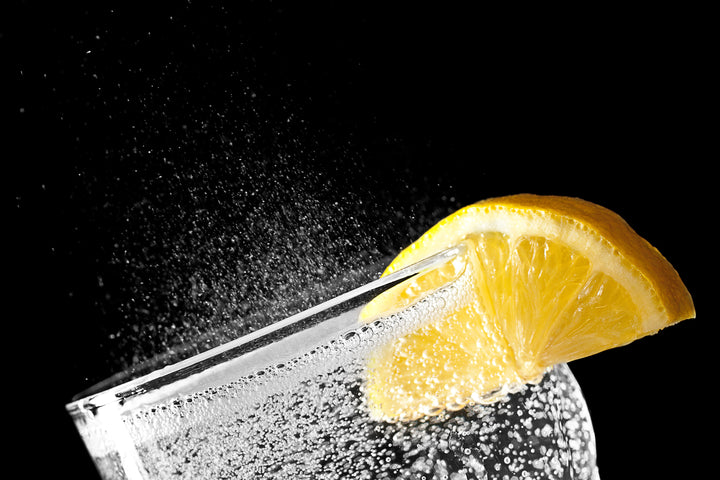Have you ever spotted a bottle or can of sparkling water and thought to yourself, "What exactly is sparkling water?". Well, let us fill you in!
Sparkling water is simply water that has been infused with carbon dioxide gas, giving it a refreshing and effervescent quality. It's called "sparkling" because of the tiny bubbles released when you open or pour it, adding a little extra sparkle to your drink.
You can find both natural and man-made varieties of sparkling water, with natural versions coming from natural sources like mineral springs and man-made versions created by infusing plain water with carbon dioxide.
The History of Sparkling Water
The true pioneers of sparkling water were actually two scientists: Joseph Priestley and Torbern Bergman. Priestley discovered a way to infuse water with carbon dioxide in 1767, while Bergman improved upon Priestley's method in the late 18th century. These two trailblazers laid the foundation for the sparkling water we know and love today.
Sparkling water gained popularity as a refreshing and thirst-quenching beverage, and it has continued to be popular due to its versatility as a mixer for cocktails and its perceived health benefits compared to sugary soda. In recent years, the popularity of sparkling water has surged even further due to the trend of people seeking healthier beverage options. One such company that has contributed to this trend is SodaStream, a home carbonation system that has been trusted by millions of households since its establishment in the UK in 1903. With a longevity of over a century, SodaStream has become a staple in many homes, allowing people to enjoy fresh sparkling water at the convenience of their own home.
Health Benefits of Sparkling Water
Reduce Dehydration
Like plain water, sparkling water can contribute to daily fluid intake, which is essential for maintaining proper hydration. It's also worth noting that some people may prefer the taste and fizz of sparkling water, which may make it more enjoyable to drink and, in turn, help to increase fluid intake.
Weight Management
Sparkling water can be a good choice for people who are trying to manage their weight, as it is low in calories and sugar. Most types of sparkling water are calorie-free since they are simply water infused with carbon dioxide gas. This makes sparkling water an excellent alternative to sugary soft drinks and other sweetened beverages, which can contribute significantly to daily calorie intake.
Improve Digestion
The carbonation in sparkling water may stimulate the production of stomach acid, which can aid in the digestion of food and the absorption of nutrients. Additionally, the bubbles in sparkling water can help promote food movement through the digestive tract, potentially relieving constipation and bloating. According to some research, consuming sparkling water may alleviate indigestion and constipation, as well as enhance the emptying of the gallbladder.
Improve Swallowing Ability in the Elderly
If you have an elderly loved one who has trouble swallowing, you may want to consider adding a little sparkle to their water!
Studies found that elderly individuals with difficulty swallowing (dysphagia) who drank carbonated water had an easier time swallowing compared to those who drank plain water. Another study also found that seniors who sipped on sparkling water had improved swallowing function and were less likely to experience aspiration (when food or liquid entered the airways).
So go ahead and add a little fizz to your loved one's hydration routine – it could make a big difference!
Which Sparkling Water Brand Should I Choose?
Have you ever thought about all the adventures a bottle of sparkling water goes on before it ends up in your hands? Commercial brands of sparkling water are often transported long distances, stored on shelves for extended periods of time, and subjected to high temperatures, which can all contribute to the presence of plastic particles in the drink. Yuck! But don't worry, there's an alternative to all this plastic-particle-filled bottled water: SodaStream.
Conclusion
With SodaStream, you can make your own sparkling water at home and avoid all the plastic bottle drama. No long transport times, no extended shelf stays, no high temperatures to worry about and most importantly, complete control of what goes into your drinks. With a wide range of flavours to choose from, you can mix and match to create your perfect sparkling water blend.
The next time you're craving some bubbles, just remember that with SodaStream, you can enjoy your sparkling water without worrying about calories and plastic particles. So why not give it a go and see how SodaStream can fit into your healthy and sustainable routine? Your taste buds (and the planet) will thank you! Click here to browse SodaStream Water Maker now!
References
Cuomo, R., Grasso, R., Sarnelli, G., Capuano, G., Nicolai, E., Nardone, G., Pomponi, D., Budillon, G., & Ierardi, E. (2002). Effects of carbonated water on functional dyspepsia and constipation. European Journal of Gastroenterology & Hepatology, 14(9), 991–999.
Heid, M. (2019, May 29). Your Bottled Water Probably Has Plastic In It. Should You Worry? Time; Time.
kaputk. (2022, February 15). Is Sparkling Water Good for You? Cleveland Clinic; Cleveland Clinic.
Morishita, M., Mori, S., Yamagami, S., & Mizutani, M. (2013). Effect of Carbonated Beverages on Pharyngeal Swallowing in Young Individuals and Elderly Inpatients. Dysphagia, 29(2), 213–222.
Nation, S. (2020, September 14). The History Of Seltzer Water And Its Surge In Popularity | Seltzer Nation. Seltzer Nation.
Overström, B. (2017, April 27). The history of sparkling water. Borg & Overström; Borg & Overström.
Torrens, K. (2022, July 8). Is sparkling water good for you? Bbcgoodfood.com; BBC Good Food.
WebMD Editorial Contributors. (2020, October 7). Sparkling Water: Are There Benefits? WebMD; WebMD.



